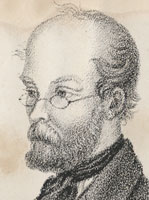Georg Ludwig Kobelt (1804-1857)
 Georg Ludwig Kobelt was born in Kork on March 12, 1804. He was the youngest of three sons, and even at a very young age was recognized as a patient and skillful boy.
Georg Ludwig Kobelt was born in Kork on March 12, 1804. He was the youngest of three sons, and even at a very young age was recognized as a patient and skillful boy.
In the fall of 1824 he began studying law, but this discipline did not captivate his interests. So, he changed his major to medicine, and on September 3, 1832, after only 7 semesters, he earned his doctorate with "Summa cum laude".
In April of 1835 he was chosen by Tiedemann to work as a prosector in Tiedemann's department. Two years later, in 1837, he was granted financial assistance to visit all of the German collections of anatomical specimens as well as those in London, Leyden and Strassburg. Shortly after Kobelt was hired, Tiedemann employed another professor, Theodor Bischoff (1807-1882), who, like Vincenz Fohmann (1794-1837) before him, was Tiedemann's son-in-law.
These two gentlemen, Kobelt and Bischoff, had very different personalities, as Adolf Kussmaul (1822-1902) has noted in his book "Jugenderinnerungen eines alten Arztes" (Memories of an old doctor). Kobelt was described by Kussmaul as a "skinny, weakly little man, very nervous, a little pot which could easily boil over", while Bischoff was a strong, massive man, who liked to force open locked doors instead of opening them gently.
Bischoffs lectures were described as dry. In contrast, Kobelt enhanced his lectures with numerous prosections, which he had dissected himself. He was very popular with his students; he encouraged them, even financially, whenever he could. In 1841 Bischoff and Kobelt were involved in a scandal concerning the publication of an anomaly discovered during the dissecting course.
Specifically, in 1840 students discovered white punctured muscles on a cadaver, and both men, Bischoff and Kobelt, got into a huge conflict as to who should have the right to publish the finding. On August 5, 1840 both were issued a warning by Tiedemann, but in the end it was Kobelt and not Bischoff who was forced to exchange his position with Alexander Ecker in Freiburg.
After a few years in Freiburg Kobelt became a professor in the Department of Anatomy. Because he was more interested in macroscopic than microscopic anatomy, he enriched the collection in Heidelberg and Freiburg with many beautifully dissected gross anatomical specimens and prosections. One of his specialities was the dissection of the vasculature of bones.
For example, he opened temporal bones to expose the inner ear, or prepared the skull to most effectively exhibit the foramina and diploe. The Institute of Anatomy in Heidelberg still has dissections which can be traced to Kobelt because of his excellent descriptions. However, he is famous for his research on the development of the genitals, which he described in 1847 in his book about the Kobelt’s tubules. Kobelt died of tuberculosis on May 18, 1857.
To the digitized works by Georg Ludwig Kobelt
Requests, suggestions and criticism to Dr.sc.hum. Sara Doll





 Universitaetsbibliothek Heidelberg
Universitaetsbibliothek Heidelberg